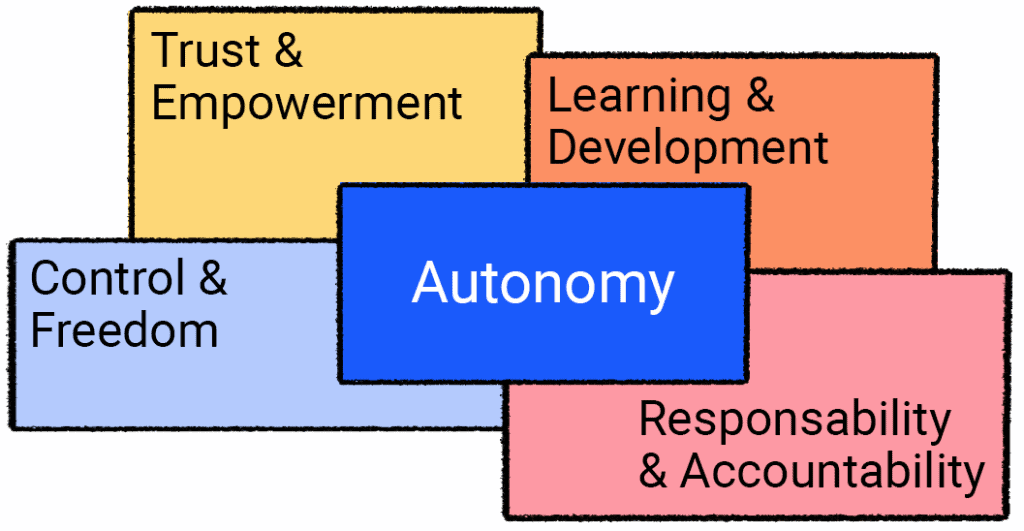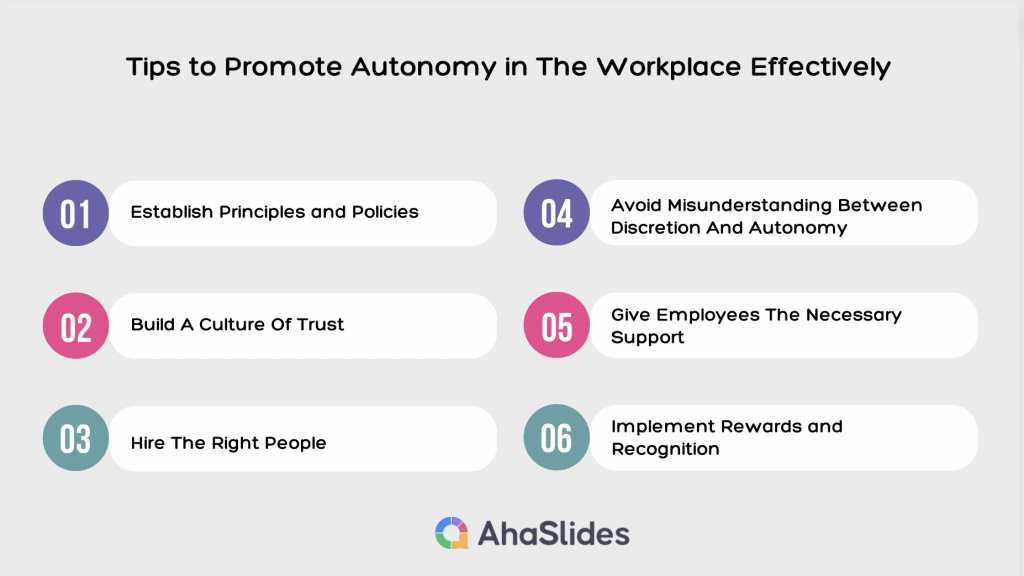工作場所的自主權以及裁量權應用於現代工作環境時,不僅會導致工作質量,而且會導致員工能力和心態發生重大變化。
據稱,為了能夠建立一個富有創造力和高品質的工作環境,吸引和留住人才,促進創新,促進工作場所的自主權。這是真的嗎?
這篇文章深入探討了最新趨勢——工作自主性,它是什麼,為什麼它很重要,它與自由裁量權有何不同,以及如何正確應用它並預防危害。

目錄:
什麼是工作場所的自主權?
工作場所的自主性是指個人或實體不受外界控製或影響而獨立行動的能力。它是指根據個人自由意志和行動進行行動和選擇的能力。自主性通常與個人自由和自我管理連結在一起。
當人們在工作上缺乏獨立性和決策權時,這就被稱為職場自主性不足。他們可能要遵守嚴格的規定、僵化的程序,並承受上級的持續監督。
工作中自治的流行例子之一是減少工作量和對總部高層管理人員的依賴,一項大工作有多個部門並且禁止專業化。公司應該允許每個部門能夠處理其預算或策略。這意味著部門負責人可以請求和管理預算,而無需執行董事會的批准。這也意味著他們在部門內擁有不受限制的創造力和財務自主權。

工作場所的自由裁量權和自主權有什麼不同?
儘管兩者都代表了對任何特定問題的選擇和行動判斷的自由,但工作中的自主權和自由裁量權之間仍然存在明顯的區別。員工在工作上擁有一定的自主權並不代表沒有限制。他們可以決定如何完成工作,只要符合整體組織和 團隊目標。自由裁量權是基於一個人對情況的理解,同時考慮到相關因素和限制,並在某種程度上仍然利用他人的某種程度的指導或方向。
發現工作場所自主權的重要性
想像一下,被告知如何完成每項任務、何時完成,甚至如何思考它。你幾乎沒有個人判斷、創造力或獨立的空間 決策。這本質上就是職場上缺乏自主權的感覺。這是阻礙創新和成長的主要原因。特別是,那些感覺受到控制、無法做出有意義貢獻的員工可能會失去動力、感到無能,而微觀管理可能會侵蝕他們的自我價值,等等。
然而,工作中對自主權的誤解和過度使用也是重要議題。很多員工以此為藉口推卸責任、忽視 團隊合作,或錯過最後期限。當雇主未能分享明確的期望和指導方針時,個人的方法可能會有很大差異,導致品質和產出不一致。他們也可能會犯一些未被注意到的錯誤,從而導致返工和延誤。
因此,雇主在工作中建立和維持自主文化至關重要。那麼,該怎麼做呢?下一部分揭示了一些在工作場所培養自主權的有用技巧。
有效促進工作場所自主權的技巧
你如何在工作中表現出自主性?以下是領導者有效建立自主文化的一些重要建議。

1. 制定原則和政策
您可以建立一個框架,根據您的公司如何監管自主權來捍衛決策權、自主權以及與之相關的政策。
透過為公司的每個領域制定不同的政策,您可以讓員工在無需幹預的情況下解決問題、做出決策並監督他們的工作。
接下來,確保員工了解自治的界限和期望。
如果無法制定通用政策,可以提出補充原則。這些原則旨在提供最佳實踐指導,同時不影響任何可能被視為限制性或完全不適合工作自主性的員工政策。如果溝通得當,這些原則可以與政策一樣有效,同時也能提供探索新工作方式的機會。
2. 建立信任文化
公司應該是一個管理者和員工相互信任、遵守最後期限並以最高成本效益成功完成專案的地方。此外,流程應該透明。建立一種員工以價值觀而非規則為指導的文化。
因此,它需要時間並且必須從頭開始建立。員工第一天進入您的公司。你應該支持重視責任的組織文化, trust和尊重,鼓勵和引導工人實現目標,而不是強迫或威脅。
3. 僱用合適的人
並非每個人都適合您的業務,也不是每個人都適合您的業務。
確保 招聘過程 足夠徹底,可以讓員工不僅在工作中表現出色,而且能夠融入您試圖建立的文化。尋找有經驗且能自給自足的人;您可以信任的人以及您認識的人會帶來正面的結果。您只能透過這種方式創建您想要的勞動力。
4.避免對自由裁量權和自主權之間的誤解
自主性是指不受外界指示或控製而獨立做出決定的能力。相反,自由裁量權是指在預定範圍或指導方針內做出決定的能力。這兩個概念雖然有些相似之處,但並不相同。混淆和誤解這兩個術語可能會造成混淆和誤解。
5. 給予員工必要的支持
激勵員工不斷進步。智力、經驗和技能都是可以提升的;然而,即使擁有一份工作,也不代表他們應該停止努力提升。員工將從經驗的累積以及情境判斷和決策能力的提升中受益。
當允許採用成長心態時,員工將努力變得更加專業並對所有任務的工作負責。出於多種原因,這一點至關重要,其中最主要的是職業道路的發展和員工忠誠度。
6.實施獎勵和認可
支持和培育一種文化 讚賞和認可 這將鼓勵員工在工作場所的自由裁量權和自主權,考慮實施獎勵和認可,讓您能夠透過各種個人獎勵來吸引您的團隊。向員工展示他們的貢獻受到主管和同事的重視,並鼓勵員工每天在工作中盡最大努力。員工敬業度和留任率將因此而提高。
🚀 啊哈幻燈片 是表彰員工對公司貢獻的絕佳工具。您可以使用這款精美且可編輯的模板,為所有會議、演示和報告增添亮點和影響力,並鼓勵員工在工作中發揮自主性。
常見問題
自主權的重要性是什麼?
工作場所自主的好處使個人能夠:
- 以他們獨特的方式表達自己。
- 獨立可以帶來更具想像和吸引力的語言使用。
- 自由裁量權和自主權應該並存,以確保正確的語言使用。
職場自治有哪些問題?
當工作自主權增加時,決策活動會佔用大量資源,導致可用於處理工作任務的資源減少。此時由於工作效率下降、個人工作壓力增大,主觀幸福感會下降。
此外,能力較弱的員工在獨立工作時,如果沒有明確的目標和計劃,就會感到不清晰。因此,可以加入一些具體的原則來支持員工的創作自由,而不是讓公司通用的政策來左右他們的行為。
什麼是過多的自主權?
在工作場所被賦予過多自主權的員工必須規劃自己的工作量。這既是一種功能性資源,也是一種消耗。因為在當今的職場中,員工不僅被允許自主決策,也被要求這樣做。
參考: 內容權威







